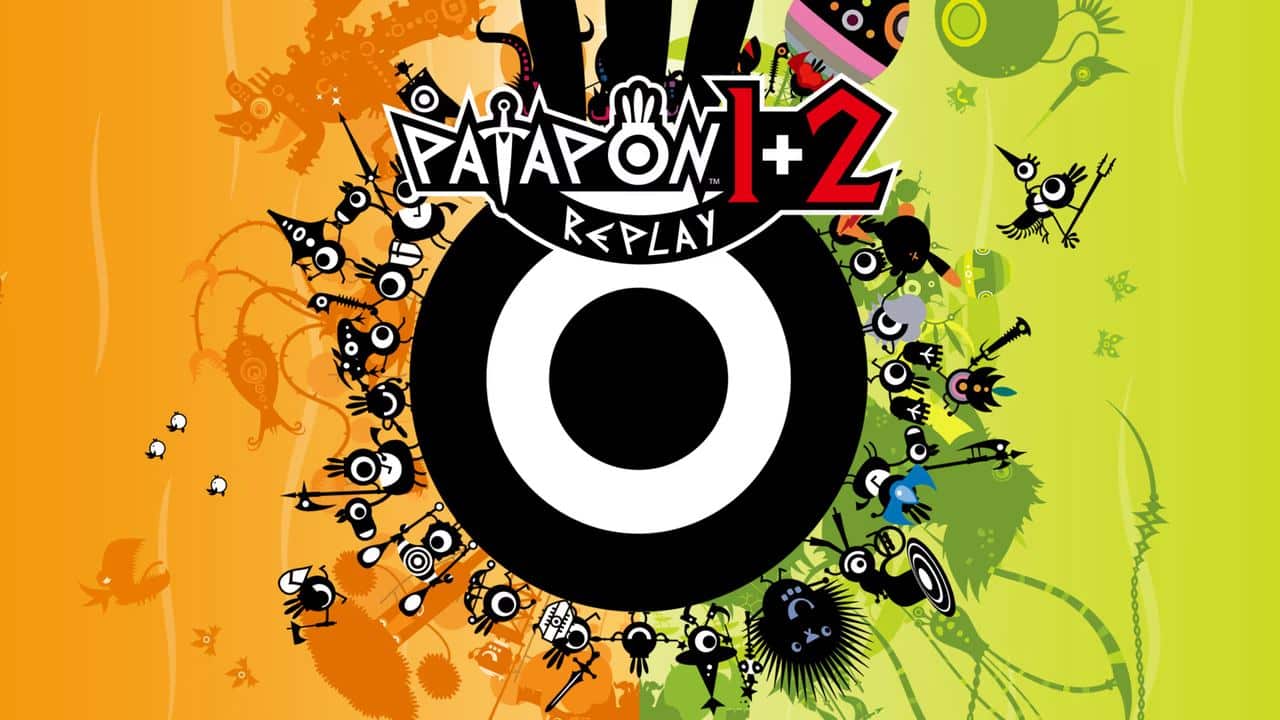
Patapon 1+2 Replay brings back one of the most distinct rhythm-strategy hybrids from the PSP era, now on modern platforms with a few new quality-of-life tweaks. Developed originally by Pyramid and Japan Studio and now published by Bandai Namco, this collection includes both Patapon and its sequel, playable individually from a shared launcher. The package sticks close to the original vision, with minimal changes to gameplay or presentation outside of some helpful interface and accessibility options.
I remember picking up the original Patapon during my PSP years, mostly curious after hearing friends describe it as “a rhythm game with marching eyeballs.” That sounded just weird enough to check out. What hooked me wasn’t just the catchy drumbeats. It was the mix of strategy and repetition, trying to time everything just right so my little army could survive another boss fight. Back then, it felt like nothing else on the market.
Coming back to Patapon 1+2 Replay now, it still works. The rhythm is familiar, the challenge still sharp, and those chants stick with you all over again. This collection doesn’t try to reinvent anything, but for fans like me, it’s a chance to relive two creative highlights from the handheld era.
Chanting Toward Earthend
Patapon 1+2 Replay tells the story of the Patapons, a small tribal army guided by their god, referred to as the Mighty One. You take on that role, leading them through a long march toward a sacred place called Earthend in search of something simply known as “IT.” The first game is focused on rebuilding the Patapon army after years of decline, while the second begins with the tribe shipwrecked on an unfamiliar land, still chasing their mythical goal.
The setup is still the same. You drum out commands, and your little eyeball army chants them back while marching or fighting. Most of the story plays out through short, quiet cutscenes using simple text and animation. There’s a more serious tone underneath everything, with themes like survival and belief pushing the Patapons forward in their journey. Even so, it never feels too heavy. The bold art style helps keep things light, even when things get rough.
The minimal style still has its charm, but some parts feel dated. Text scrolls slowly during certain scenes, and you can’t skip or speed up much of it. There’s no voice acting or new narration either, so a few moments fall a bit flat. If you’re not paying close attention, it’s easy to miss a line or two.
The story isn’t really the focus here, but it does enough to keep things moving. Patapon 2 adds a bit more variety with new enemies, allies, and a broader sense of the world. Still, it’s the chants and commands that stick with you more than any specific cutscene.
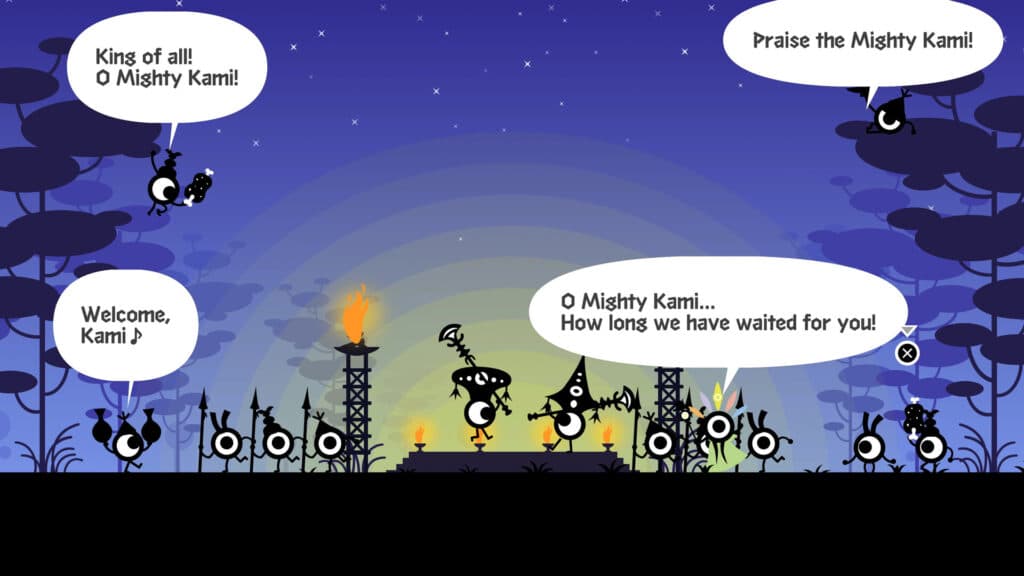
Marching to the Beat Again
Patapon 1+2 Replay sticks with the same rhythm-based gameplay that made the originals stand out. You control your army by tapping out four-beat commands using the face buttons. Each button makes a sound like Pata, Pon, Chaka, or Don, and combining them tells your Patapons what to do, whether it’s moving, attacking, or defending. Timing really matters. Get it right and your army listens. Slip up and things can fall apart fast.
When you build up enough combos, you enter Fever mode. This boosts your army’s power and turns up the energy of the chants. It feels great when you lock into that rhythm and your team charges ahead without missing a beat. But slipping up at the wrong moment, especially during a boss fight, can throw the whole mission off.
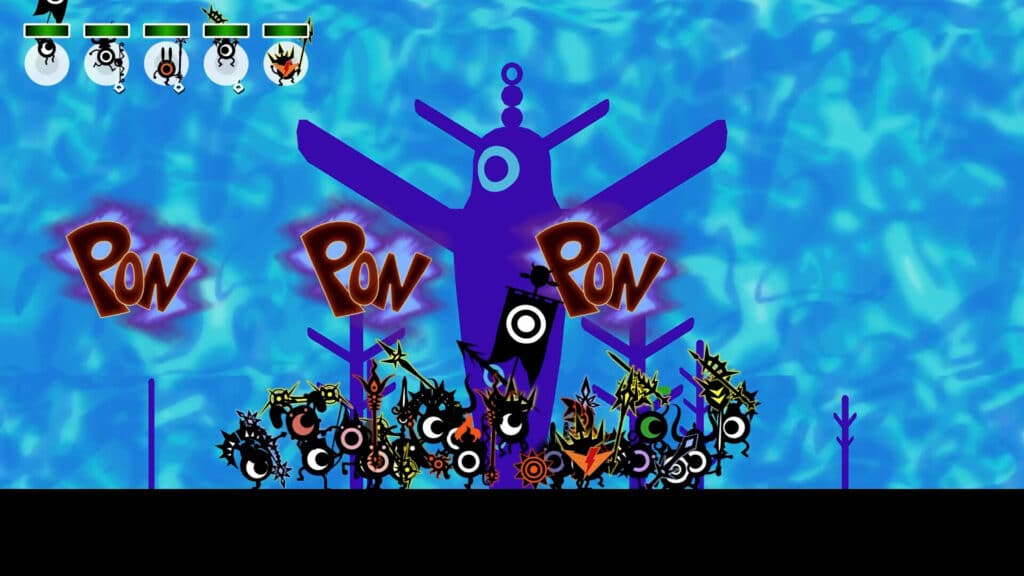
I had a few rough runs early on where I completely lost the rhythm. During one boss battle, I mistimed a command and broke Fever mode right as a massive bird slammed into my front line. Half my squad went down in seconds. I had to regroup, grind for better gear, and replay the level before I could get past it. It was frustrating, but finally getting it right was so satisfying.
Patapon 1 gives you a solid introduction to the basics. It teaches you how each unit works, what gear does, and how important timing really is. But once you’ve learned the rhythm, the first game starts to feel a little thin. That’s where Patapon 2 picks things up. It adds new commands, unit types, and a lot more room to experiment. Between the Evolution Map, Hero Units, and extra missions, the sequel gives you more reasons to keep going.
Both games still involve a fair bit of grinding. You’ll replay missions to gather materials, unlock new Patapons, and strengthen your squad. If that loop clicks with you, it’s satisfying. If not, the repetition might wear you down.
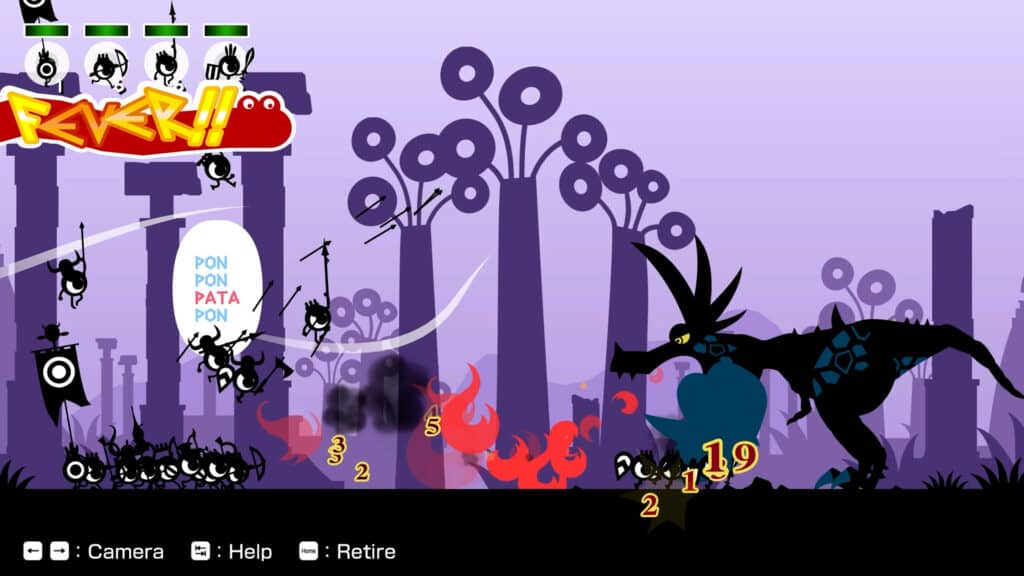
Simple Style That Still Works
Patapon 1+2 Replay sticks with the same bold, minimal look from the PSP days, just cleaned up for today’s standards. Whether you’re playing on a TV or handheld, everything scales nicely. The colours pop, the animations run smooth, and the simple style makes it easy to stay focused on the rhythm.
Both games now run at 60 frames per second and look crisp in HD. They’re not flashy, but they don’t need to be. The game cares more about keeping things clear and on beat than trying to wow you with flashy visuals. On-screen cues like the border pulse help keep you on beat, especially during tougher missions.
The music is still one of the best parts. Every command you enter feeds directly into the soundtrack, and once you hit Fever mode, the energy picks up fast. The Patapons chant louder, the percussion gets more intense, and you can feel the momentum build. Even outside the battlefield, the main themes and tribal percussion loops are catchy enough to get stuck in your head long after you stop playing.
There are some updates here, like optional difficulty settings, command guides you can pull up mid-battle, and tips that unlock as you progress. These help modernize things without changing how the game feels.
Input lag can be an issue depending on your setup. Some configurations feel more responsive than others, and switching display modes can affect timing. There’s a manual timing adjustment in the settings, but it relies on trial and error. Since the game doesn’t offer clear guidance, it might take a few tries to get things feeling right.
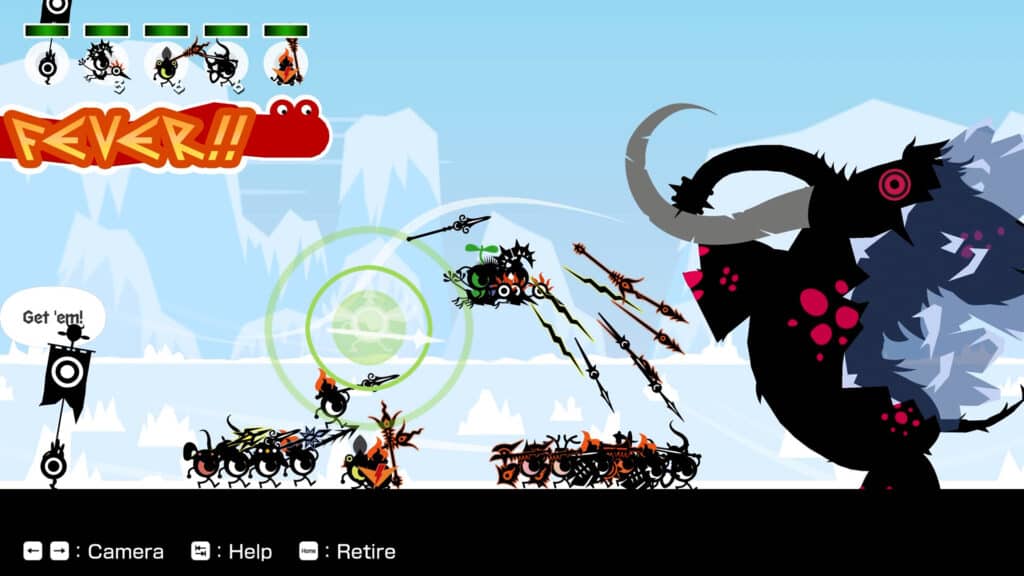
Patapon 1+2 Replay Proves These Rhythm Games Still Have Life
Patapon 1+2 Replay doesn’t try to reinvent anything, and that’s part of what makes it work. These games were already doing something different back on the PSP, and that rhythm-command formula still holds up. You drum out orders, time your inputs, and slowly build a weird little army that shouts its way through every battle. It’s as strange and satisfying now as it was back then.
I forgot how intense it could feel to mess up a beat and watch everything fall apart. But I also forgot how good it feels to finally sync everything up and march straight through a mission that gave you trouble the day before. That loop of try, fail, and try again is still rewarding.
Patapon 2 definitely comes out on top between the two. It’s bigger, smoother, and has way more ways to customize your squad. The first game is still fun, but going back after finishing the sequel makes it feel more limited. That said, both are worth playing, and having them bundled together just makes sense.
There are definitely things that could’ve made this collection stronger. A proper timing calibration tool would’ve helped, and some of the story sequences could’ve used a refresh. It’s also a shame that Patapon 3 isn’t part of the package.
Still, for rhythm fans or anyone curious about one of the PSP’s more creative releases, this is a solid return. It’s not a remake or an overhaul, just two strange and charming games that still know how to get stuck in your head.
Patapon 1+2 Replay

Summary
Patapon 1+2 Replay brings back two of the PSP’s most unique rhythm-strategy games with sharper visuals, smooth performance, and a few helpful tweaks. The core gameplay is still fun and challenging, and Patapon 2 gives you more to mess around with. There’s nothing new in terms of content or story, but the rhythm-command loop still feels great. Whether you’re coming back or trying it for the first time, it’s a strange little throwback that still works.
As always, remember to follow us on our social media platforms (e.g., Threads, X (Twitter), Bluesky, YouTube, and Facebook) to stay up-to-date with the latest news. This website contains affiliate links. We may receive a commission when you click on these links and make a purchase, at no extra cost to you. We are an independent site, and the opinions expressed here are our own.










